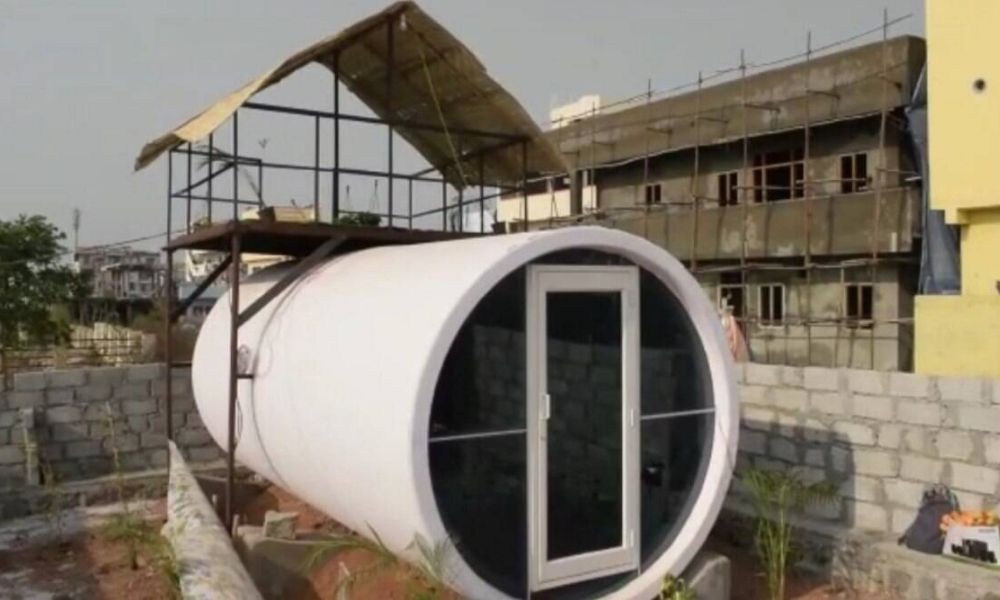
Image Credit: The Indian Express
Engineering Student Comes Up With Housing Solution For The Needy
Writer: Ratika Rana
Her primary objective is to inform, promote, educate and cultivate readers through writing.
Telangana, 30 July 2021 12:38 PM GMT
Editor : Ankita Singh |
A literature lover who likes delving deeper into a wide range of societal issues and expresses her opinions about the same. Keeps looking for best-read recommendations while enjoying her coffee and tea.
Creatives : Ratika Rana
Her primary objective is to inform, promote, educate and cultivate readers through writing.
Perala Manasa Reddy has been hailed as the Champion under the government's Aatmanirbhar Abhiyan for building homes out of sewage pipes for the underprivileged.
India is a diverse country, and the population is unevenly distributed. More than 1.77 million people in the country are homeless. Inadequate housing facilities force the underprivileged to live in temporary straw huts or use huge containers to protect them from harsh weather conditions. Despite this, everyone in the country aims to have a house of their own. A 23-year-old civil engineer in Telangana aims to fulfil such hopes of many. Perala Manasa Reddy launched OPods or micro homes made out of concrete sewage pipes of 2000 metres. The micro-homes comprise one bedroom and a built-up area of 120 sq-feet.
Coming from a humble background in Bommakal village of Telangana's Karimpur district, Manasa was raised by a single mother. She credited her mother and Telangana Social Welfare Residential Educational Institutions Society (TSWREIS) for empowering her with an education that enabled her to dream. She completed her B.Tech in civil engineering from Lovely Professional University in May 2020. Post this; she gave six months to study the designs used in Japan and Hong Kong that suit the needs of people as per the weather conditions. What started as an initiative for the underprivileged eventually transpired into experimental mobile housing that might benefit the underprivileged sections of society.
Cost And Facilities
These OPods comprise a bedroom, kitchen, hall, washroom and shelves. These micro houses have connectivity of electricity, water and drainage system. On top of the sewage pipe, there is a balcony-kind lounge area suitable for one or two people. The Indian Express quoted Manasa saying, "This is the first-of-its-kind model in India. In 40 to 120 square feet, we have a customised all-weather home with a life span of 100 years. The cost for these homes varies from ₹ 3.5 lakh to ₹ 5.5 lakh depending upon people's wishes for a two or three-bedroom micro home."
To test the viability of these OPods, she convinced a migrant worker to live in them for a few days. He was provided with electricity and food. After his stay, they took his feedback and are planning to improvise the homes further. Reddy launched her company Samnavi Constructions with a business management student from her college and is now working on designs of 2, 3 and 4 OPod houses. She has already received more than 200 orders from Andhra Pradesh, Kerala, Odisha and Tamil Nadu.
Even though there are container homes available under similar concepts, these houses are better for keeping them cool and having a longer life. Apart from affordable housing for the poor, these designs can also be used for resorts, restaurants and mobile homes. Senior IPS Officer and Secretary of TSWREIS Dr RS Praveen Kumar remembered Manasa as an active student who wanted to chart her course and pursue higher studies, a rarity in small villages. He called her idea of affordable housing radical and said that this was just the beginning.
Reddy came from the first batch of 'voice for girls' and was a trained 'Sakhi'. She also represented social welfare schools in UNICEF meetings in Bengaluru, Karnataka. However, she said that she received absolutely no backing from people when she initially proposed the idea. Her father expired when she was in third grade. After which, her mother sold all her earnings to make her dream come true.
She was honoured by the government of India as a 'Champion' under India's Aatmanirbhar initiative. The government has also launched schemes like Pradhan Mantri Gramin Awas Yojana as a housing scheme for vulnerable sections of the society that would provide pucca houses and basic amenities to the benefactors. However, the discrepancy between the set target and the achieved target leaves one in a dilemma whether or not to believe the party in power after the elections.
The Larger Question
The larger question that we face today is why the basic need for housing is inaccessible in a country that aims to take on the world is? The crux of the housing crisis in India remains to be access and control over the land and its use. In the country, the growth in urban population and the lack of housing facilities have pushed 26 to 37 million households to opt for informal housing. In informal settings, dwellers live in poor conditions with a lack of clean drinking water, sewage and drainage. They constantly live under the fear of eviction or demolition due to limited property rights. The lack of planning refers to the fact that informal housing will be a part of society in the foreseeable future.
A survey by fsg.org mentions that the top-rated needs of informal housing families are toilets(44 per cent), water (36 per cent) and drainage (28 per cent). Instead of lending a helping hand to improve the living conditions for the urban poor, the government's redevelopment models further stretches the gap in prevalent poverty. Privatising public land reduces the already shrinking area of low-income residents.
According to an estimate, all of the urban poor in India lives on less than 5 per cent of the land. People across the country demand rights of the land they get, not just state-built tenements. If the country's legal framework incorporates the "social function of land" system, it would recognise the need for equality in land distribution that would promote social justice. India could adopt a policy similar to Brazil, in which the land acquired by the urban poor for housing for an uninterrupted period of five years is transferred to them.
Securing the land in the name of women would contribute to better gender equality while addressing gender-based discrimination. Promulgating the right to housing legislation and adequate investment in low-costing housing can be India's trick to solve the problem. Providing satisfactory health services and food for the people can be like a cherry on the cake, but it seems too much to ask for in the current scenario.
Mitigating the housing and land crisis in India would achieve greater economic and social security. The lower-income would finally live in peace, security and dignity. Housing challenges are not unique only to India. Millions are living on the streets or under unviable housing conditions. The crisis needs to be addressed in a human rights-friendly approach, ensuring equality for all on the receiving end.
Also Read: Bengaluru To Receive Prototype Of Electric Buses By August 10
 All section
All section














